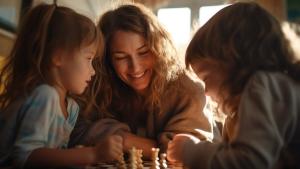
Challenges Of The Family Chess Tradition. A Lesson in Letting It Go
I never imagined I would be one of those uncompromising parents who push their fearful child off the boat, in the middle of a lake, to teach her to swim, fast, and the hard way. Yet, here I stood battling with my eight-year-old daughter, Lea*, in an elementary school washroom, about to do the same. Only instead of a lake, I was about to push her into the dreaded chess club. The stakes were high.
*Name changed for confidentiality.
It’s not that Lea didn’t like chess. There was just a peculiar problem with it, and she knew it way before I realized what it was.
“Mama, please, I don’t want to go to the chess club,” she pleaded when I first delivered the great news of her registration.
“I don’t understand,” I replied, “you love chess. You’re good at it. Why don’t you want to go?”
“I just don’t,” she said, with no further explanation.
Until that point, most of Lea’s chess learning had happened at home with me or my mother and online. In February 2023, though, I wanted Lea to experience chess in person. With the lack of chess friends, her motivation was seriously dwindling, and with it, her desire to train. Lea’s chances of being a top girl player in the country, something I had envisioned as a possibility for her, were quickly evaporating. Chess needed to become social, exciting, and competitive—hence, the chess club.
So, when Lea said she didn’t want to go, I was baffled. She’d never been in a chess club before, but she played in several online kid tournaments during the pandemic—with the same kids attending this club. She did well and already knew everyone’s names—or, at least, their usernames. LittleFish, ChennyChen, and TheDankDork were all part of our daily chess conversations throughout the pandemic and I was curious to see what they looked like in real life.
I traced Lea’s little pointy nose with my finger as I lay next to her in bed the night before our first club visit. I recalled her first and last in-person kids’ tournament a few months prior, where she won second place in her grade three section. But was this where things went wrong?
Lea must have read my mind: “I don’t want to go to the club,” she confessed, “because it’s going to be all boys, and one of them, will have a crush on me.”
Aha! I knew it! This wasn’t about chess. It was about … oh, no, the boys! And the visible minority of girls and women in chess. In that in-person tournament she attended in her grade, Lea stood out as one of the very few girls. It must have left a profound mark on her that I wasn’t aware of.
The next afternoon I found myself standing at the entrance of the chess club with Lea. We were the first to arrive. “Let’s see how many girls we can spot,” I said enthusiastically, and we counted: One boy, two boys, three boys … Which one is TheDankDork? Four boys, five boys … A little panic settled in our hearts … six boys… Where is LittleFish? She’s one of the few girls from the online tournaments. Seven boys … Lea was now fighting a tear. Eight boys … There were no girls in sight.
“See!” she shouted and ran to the bathroom, I behind her.
Competitive, high-level chess, runs in my family and has for three generations now; Lea is the fourth. Chess is in our blood, in our DNA. And so, somehow, it hurts to see Lea lose interest in chess, especially when she loved it so much!
Standing in the school’s washroom, listening to Lea cry from disappointment and fear of being singled out, I sensed my failure as a mother and as a teacher—someone who is supposed to pass on the torch.
“Just go once and you can quit after if you want,” I offered, but that provided no reassurance to her. I had to act fast! Pushing my emotions aside, I rationalized that this experience wasn’t going to be about chess anymore. It was about facing fears and challenges, getting out of her comfort zone, and plunging into the unknown.
And, so, with all my might and strength, I lifted my sobbing girl off the ground and whisked her out of the washroom like a superwoman saving a child from a burning fire.
That’s how I imagined it to be anyway. In reality, Lea was too heavy for me, so I awkwardly let her limp body slide through my arms, caught her under the armpits, and dragged her out of the washroom, in disgrace.
When we entered the club, I spotted one girl with long blond hair like Lea’s, and after quick introductions to the girl and the organizer I… ran.
I ran so that Lea wouldn’t cling to me. I ran because I wanted her to be social and independent. I ran from my own guilt and shame because I felt selfish for pushing Lea to pursue the go-to-the-chess-club dream I had for her.
While waiting for the club to finish, I was hyperventilating, tormented by the question, “Am I a good parent?” I remembered asking my mother once when I was a teen: “Mom, why didn’t you take me to piano, skating, or gymnastics? All I know is how to play chess.” Well, that was the life in the former USSR, where I spent my early childhood. Everyone played chess there, including lots of girls.
Today, here in Canada, I realized that in addition to the significant gap in the male/female ratio in chess, serious pursuit of chess simply doesn’t fit our current lifestyle. How strange. Not only does my daughter love to participate in a variety of activities, but I also try to keep up with our neighbors, who enroll their children in absolutely everything—except chess. And we’re just trying to fit in.
The moment of truth came when I picked Lea up from the club. “So,” I asked, “how did it go?”
“Good,” she said, smiling. Never have I experienced such an immense, heavenly relief. Was I not the best mother ever!?
Driving home in the car, I asked, “So, what did you like about the club?” No answer. In the rear-view mirror, I saw Lea’s coquettish smile and I had my answer before she could pierce my heart with her reply: “Cookies and a juice box.”
I smiled… and resigned.
But sugar can go a long way. For the three blissful months that followed, Lea happily went to the chess club. Life was once again emotionally comforting…
Until one day, in May, Lea declared in a mature and empowered way: “No more chess club, mom. Let’s continue our learning at home.”
“Okay,” I sighed, knowing perfectly well it wouldn’t happen. And with that sigh, came another immense, immense relief! I’d passed on the family torch to Lea, and from that moment on, let her decide what she wants to do with its fire.
I’m certain that, one day, Lea will ask me: “Mom, why did you sign me up for piano, skating, and gymnastics, and didn’t push me enough to pursue chess? I could have been a chess champion!” And, so, I know, that no matter what I do, I will always succeed and fail as a parent, in ways only the future knows.
Since then, I’ve been living content with Beth Harmon’s quote: “Chess is not always competitive. It can also be beautiful.” So, I let Lea be guided by this beauty. There’s no rush anymore, no pressure. She’ll discover this beauty in the games she’ll play at school, parks, parties, and online. She’ll see it in movies and poetry. Boys will always be a part of chess too, but maybe Lea will find that appealing one day.
I didn’t need to push my girl off the boat. She could already “swim."



